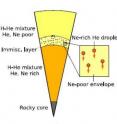Helium rain on Jupiter
Related images
(click to enlarge)
When NASA's Galileo probe reached Jupiter in 1995 and began sending back data about the gas giant, astronomers were in for a surprise: Jupiter was unusually poor in helium and neon, the two lightest noble gases. New simulations of the physics inside the planet reveal why. The results, which provide a glimpse into Jupiter's turbulent innards, are reported in the current issue of Physical Review Letters and highlighted with a Viewpoint by Jonathan Fortney (University of California, Santa Cruz) in the March 22 issue of Physics (http://physics.aps.org.) To understand how a planet might have formed and what the inside of it might be like, astronomers compare the abundances of its constituent elements with the amounts of those elements found in the sun and meteorites. Jupiter, like the sun, is mostly hydrogen and helium. But the Galileo probe showed that, while it was richer than the sun in six elements, the planet seemed to be missing a small amount of helium and a substantial amount of neon—although neon makes up 1/600 of the mass of the solar system, it made up only 1/6000 of the mass of Jupiter's upper atmosphere, where Galileo made its observations. Astronomers had assumed that Jupiter was a homogenous mix of hydrogen and helium, but this couldn't explain the observed lack of neon. Some physicists suggested that the neon was somehow sinking out of the upper atmosphere, but no one knew how this could happen.
A pair of astronomers from the University of California Berkeley has solved the mystery. Using computer simulations of the hot gases deep within the giant planet, the researchers have shown that there must be an atmospheric layer where helium condenses into droplets rather than mixing smoothly with hydrogen. Neon dissolves into these droplets, which gradually fall toward the planet's interior as helium rain. Not only do the simulations explain a long-standing mystery, but they also hint at what might be happening inside other planets. For instance, because Saturn is smaller and colder than Jupiter, physicists expect that helium rain will be even more prevalent inside this as-yet-unprobed planet.
Source: American Physical Society
Articles on the same topic
- Helium rain on Jupiter explains lack of neon in atmosphereMon, 22 Mar 2010, 17:56:32 UTC
Other sources
- Jupiter's lack of atmospheric neon studiedfrom UPIWed, 24 Mar 2010, 19:22:09 UTC
- Jupiter Has Helium Rain, Study Suggestsfrom Space.comWed, 24 Mar 2010, 12:22:01 UTC
- Helium rain washing away neon on Jupiterfrom LA Times - ScienceTue, 23 Mar 2010, 21:00:16 UTC
- Helium rain on Jupiter explains lack of neon in atmospherefrom Science BlogMon, 22 Mar 2010, 18:42:29 UTC
- Helium rain on Jupiterfrom PhysorgMon, 22 Mar 2010, 16:56:36 UTC
- Helium rain could be washing neon out of Jupiter's upper atmospherefrom Science DailyMon, 22 Mar 2010, 15:08:03 UTC
- Helium rain on Jupiterfrom Science BlogMon, 22 Mar 2010, 14:14:29 UTC
